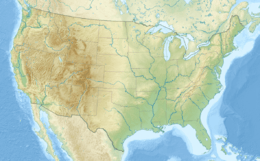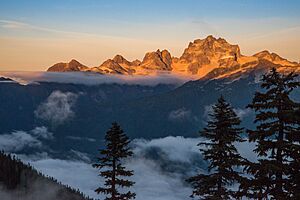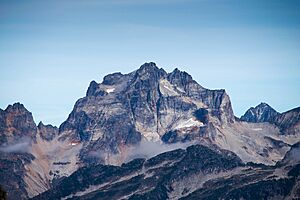Mount Redoubt (Washington) facts for kids
Quick facts for kids Mount Redoubt |
|
|---|---|

Mount Redoubt seen from Copper Ridge
|
|
| Highest point | |
| Elevation | 8,969 ft (2,734 m) |
| Prominence | 1,649 ft (503 m) |
| Geography | |
| Location | North Cascades National Park, Whatcom County, Washington, U.S. |
| Parent range | North Cascades, Skagit Range |
| Type of rock | Skagit gneiss |
| Climbing | |
| First ascent | 1930 by Jimmy Cherry and Bob Ross |
Mount Redoubt is a tall mountain in the North Cascades mountain range. It is located in Whatcom County, Washington state, in the United States. This peak is about 3 miles (4.8 km) from the Canada–United States border. It is also about 16 miles (26 km) east of Mount Shuksan.
Mount Redoubt is the 21st highest peak in Washington state. It stands at 8,956 feet (2,730 meters) tall. The mountain is part of the Skagit Range, which is a smaller part of the North Cascades. Several creeks, like Redoubt Creek, flow from the mountain. The mountain is made of a type of rock called Skagit gneiss.
This mountain is inside the Stephen Mather Wilderness area of North Cascades National Park. It is in a wild place, far from towns and hard to reach. The first people to climb Mount Redoubt were Jimmy Cherry and Bob Ross in 1930. The closest taller mountain is Mount Spickard, which is 8,979 feet (2,737 meters) high. It is about 2.9 miles (4.7 km) to the east. The Redoubt Glacier sits on the eastern side of Mount Redoubt. There are also smaller glaciers on its northern slopes.
A smaller mountain called Nodoubt Peak is about 2.9 miles (4.7 km) northwest of Mount Redoubt. Its name is a fun play on Mount Redoubt's name. Geologists who climbed Nodoubt Peak in 1967 gave it this name.
Understanding Mount Redoubt's Climate
Mount Redoubt is in a marine west coast climate zone. This means it gets a lot of moisture from the Pacific Ocean. Most weather fronts, which bring weather, travel northeast towards the Cascade Mountains.
When these weather fronts reach the North Cascades, the tall mountains force the air upward. This causes the air to cool and drop its moisture. This moisture falls as rain or snow onto the Cascades. This process is called Orographic lift. Because of this, the western side of the North Cascades gets a lot of rain and snow, especially in winter.
In winter, the weather is often cloudy. But in summer, high pressure systems over the Pacific Ocean often bring clear skies. Because of the ocean's influence, the snow tends to be wet and heavy. This can lead to a high risk of avalanches.
How Mount Redoubt Was Formed
The North Cascades mountains have very rugged shapes. You can see sharp peaks, spires, ridges, and deep glacial valleys. These amazing shapes were created by geological events that happened millions of years ago. These events also caused big changes in elevation, which led to different climates.
The Cascade Mountains began to form millions of years ago. This was during the late Eocene Epoch. At that time, the North American Plate was slowly moving over the Pacific Plate. This movement caused many volcanic eruptions. Also, small pieces of the Earth's crust, called terranes, came together. This helped create the North Cascades about 50 million years ago.
Later, during the Pleistocene period, which was over two million years ago, glaciers played a big role. Huge sheets of ice moved across the land many times. As they moved, they carved out the landscape and left behind rock debris. The river valleys in the area have a "U"-shape. This shape was created by these glaciers. The lifting of the land (uplift) and cracks in the Earth's crust (faulting), along with the glaciers, have shaped the tall peaks and deep valleys of the North Cascades.





